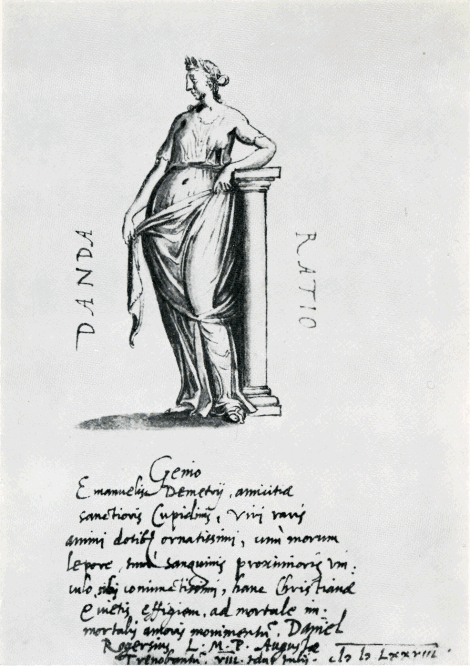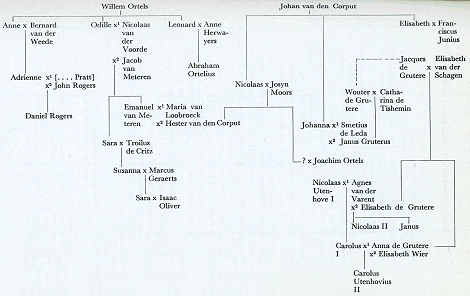Poets, Patrons, and Professors
(1962)–J.A. van Dorsten–Sir Philip Sidney, Daniel Rogers, and the Leiden Humanists
[pagina 19]
| |
II Years of studyRogers meanwhile remained in France, occasionally travelling to England. His employer, Sir Henry Norris, was replaced by Francis Walsingham - like Rogers a former ‘Marian exile’ - whose instructions were even more strictly concerned with Huguenot policy. Undoubtedly Rogers was having the best of diplomatic schooling under his ‘especial frende and patrone’Ga naar voetnoot1 and learned from him the many abilities which he could soon practise in more independent positions. Foreign activities were increasingly concentrated on all the movements that preceded the catastrophe of St. Bartholomew, and Rogers, too, remained fully occupied with French affairs. At this time his connexions with Dutchmen were not entirely suspended - witness for instance his inscription in the poet-painter Lucas de Heere's AlbumGa naar voetnoot2 - but the initial promise of strong ties with Dousa and his circle was not to be fulfilled until later. Nor did this mean a temporary banishment from the world of letters generally. On the contrary, these years were among his most active in at least one field of ‘modern learning’, factual history. He collected historical manuscriptsGa naar voetnoot3, compared traditional authors, travelled, and made extensive notes of all coins and ancient tablets he could lay hands on. His kinship with Abraham OrteliusGa naar voetnoot4, by one and all accounted the greatest geographer of his time, and consequent familiarity with the antiquarian world of historians and map-makers was an obvious source of inspiration in this field. | |
[pagina 20]
| |
In 1572 he sent Ortelius a summary of his antiquarian occupations.Ga naar voetnoot1 He had completed a work called ‘De Moribus Veterum Britannorum’ which he had still been working on in 1570Ga naar voetnoot2, at a time when Ortelius' Theatrum had recorded that ‘de veterum Britannorum moribus et legibus scripsit Commentarium Daniel Rogerius cognatus noster, sed nondum edidit’Ga naar voetnoot3. Later editions omitted the ‘nondum edidit’, but not, apparently, because the book had been published: Camden's Britannia, twenty years later, still hopefully advertised quid vero Britanni primis temporibus gesserint, quam Reipublicae formam habuerint, quibus institutis vixerint, vir optimus & eruditione ornatissimus D. Daniel Rogersius optime de me meritus suis scriptis nos docebitGa naar voetnoot4; and was afterwards obliged to substitute ‘nos docebit’ by nos docere promisit, sed cum morte immatura praereptus nihil praestiterit, de antiquis ipsorum moribus haec paucula ipsis antiquorum verbis habetoGa naar voetnoot5. A treatise on Roman Britain, he had added in his letter of 1572 to Ortelius, was causing him more trouble because there was no other information except inscriptions and old coins - for which, incidentally, he requested the help of Hubertus Goltzius the engraverGa naar voetnoot6 - to assist him in fighting traditional errors in even the most recent historians. His findings (probably the ‘Antiquae Britanniae observationes’ which have survived in manuscriptGa naar voetnoot7) were circulated without the intention of immediate publication, since five years later, to show | |
[pagina t.o. 21]
| |
 2. Drawing and inscription in the Album of Emanuel van Meteren (f.
3) by his kinsman Daniel Rogers, 1578.
| |
[pagina 21]
| |
 Figure 1
A refugee genealogy. (Cf. Hessels, Archivum; Janssen, Charles Utenhove; J.L. Nevinson, ‘Emanuel van Meteren, 1535-1612’, Proc. of the Hug. Soc., XIX, 1959, pp. 128-145; F. Pijper, Jan Utenhove. Zijn leven en zijne werken, diss. Leiden, 1883; W.D. Verduyn, Emanuel van Meteren, diss. Leiden, 1926) | |
[pagina 22]
| |
he had written on Roman Britain, he had to refer George BuchananGa naar voetnoot1 to Ortelius' Theatrum . These two projects link Rogers with the early antiquarians, and consequently with another field of Anglo-Dutch connexions. After some foreign travel, in 1572 he wrote to Ortelius in the letter quoted above that an interest in surveying Britain had taken him to Ireland in the company of some German noblemen. He added that he had bought a manuscript of Giraldus Cambrensis' Topographia Hybernica and sent it to his learned friend in Antwerp to have it printed. Strangely enough, neither Ortelius who would quote from Giraldus in his Theatrum, nor John Hooker in Holinshed's Chronicles, Stanyhurst in De rebus in Hibernia gestis, or Camden in his Anglica, who were all concerned with Giraldus Cambrensis, ever made mention of Rogers' proposed edition. Whatever these editorial intentions may have been, Rogers wrote his own book on Ireland and frequently commented on its existence. The London-Dutch merchant and historian Emanuel van MeterenGa naar voetnoot2, a kinsman, had requested on behalf of Ortelius notes connected with this book. Three years later, in 1575, Rogers told Hadrianus Junius (De Jonghe), another Dutch historian with English antecedentsGa naar voetnoot3, that some of his friends had urged him to turn the notes into a publication.Ga naar voetnoot4 Junius immediately added his plea for preserving the Topography with ‘the pictures of Irish costumes’.Ga naar voetnoot5 There is, it seems, a probable connexion between Rogers' book and the topographical description and fine set of British costume drawings by his good friend Lucas de HeereGa naar voetnoot6. Two years later Dousa was asked to supply commendatory verses; and as late as 1578 Rogers mentioned Wechel as the printer of his book while renewing his request for ‘the promised ode expected | |
[pagina 23]
| |
by my Hibernia’Ga naar voetnoot1. Perhaps the undertaking was suddenly abandoned. The only survival of Rogers' Irish studies is a long ‘Elegia, quae Hiberniae descriptionem... continet’, dedicated to Thomas Rehdiger during an early visit to Ireland.Ga naar voetnoot2 Regardless of the quality of his antiquarian studies, familiarity with Roman remains in Ireland - a subject of considerable interest to his contemporaries - must have eased his introduction to the professional experts in classical antiquity of the Universities of the Low Countries where his diplomatic missions were then beginning to take him. It also made him one of the very first in a distinguished group of writers, such as Campion and Stanyhurst, Edmund Spenser and his major informant BuchananGa naar voetnoot3, who all studied the mysterious history of that island of which Sir Henry Sidney was three times Lord-Deputy. Rogers' active interest in the past of Ireland brings him into the company of this group of scholars, and also of the Sidneys. The first English work dedicated to Philip Sidney was a poem entitled ‘The image of Ireland’, by one John Derricke, dating from about the same years; Philip Sidney's own literary début was A discourse on Irish affairs.Ga naar voetnoot4
Unlike his industrious friend Rogers, Dousa had spent the post-Parisian years at Noordwijk in aristocratic retirement, detached from all political tangle, with his newly-wed Elisabeth van Zuylen: ‘illud tempus’, as he rather bluntly put it, ‘quo primum in patriam ex Galliis reverso liberorum quaerundorum gratia uxor credo obiecta est mihi’Ga naar voetnoot5. There | |
[pagina 24]
| |
he remained, still a Catholic, and seemed to care for little else but study and poetic exercise. He was visited by Victor Giselinus (Ghyselinck), at one time a proof-reader in Plantin's OfficeGa naar voetnoot1, a lover of poetry who was soon obliged to ‘add the study of medicine to the study of letters, applying himself to it out of care for his family rather than out of his own free will’Ga naar voetnoot2. Giselinus spent two months at Noordwijk in 1568Ga naar voetnoot3, and returned in April 1570 to introduce another Flemish humanist, whom Dousa had unfortunately missed when they were both in Paris: Janus LernutiusGa naar voetnoot4. The intimate circle of these three enterprising poets - all of them well-acquainted with the new French poesy and with Rogers - widened when the two southerners, having gone to Louvain, had the good fortune to find a kindred spirit in Justus Lipsius. Dousa was immediately urged to come and join them, and there in May 1571Ga naar voetnoot5 the four began a long and fruitful friendship: on shared poetic interests they built their future renown which in another ten years was to make Dousa and Professor Lipsius perhaps the two most famous of the Leiden literati.
Meanwhile, and in spite of solemn pledges, Rogers had failed to keep in touch with Dousa after Paris. ‘Then you said to me’, Dousa publicly complained after three years of silence, ‘that you would not come to me with verses only, but with whole volumes: but why should I, like a fool, complain that you have never sent me a word, you who have obviously never given me anything but words?’Ga naar voetnoot6 Soon, however, they were able to make up for years of separation, and letters were superfluous. For having moved to Leiden in 1570, Dousa at long last decided to join the Dutch revolt. He gave up his secluded life and sailed to England on diplomatic business, less than two months after the | |
[pagina 25]
| |
massacre of St. Bartholomew, in 1572 - the year of Gascoigne's Dutch adventures, of Duplessis Mornay's escape from France, of Sidney's first continental tour - carrying a letter of introduction to William Cecil written by Hadrianus JuniusGa naar voetnoot1. |
|

